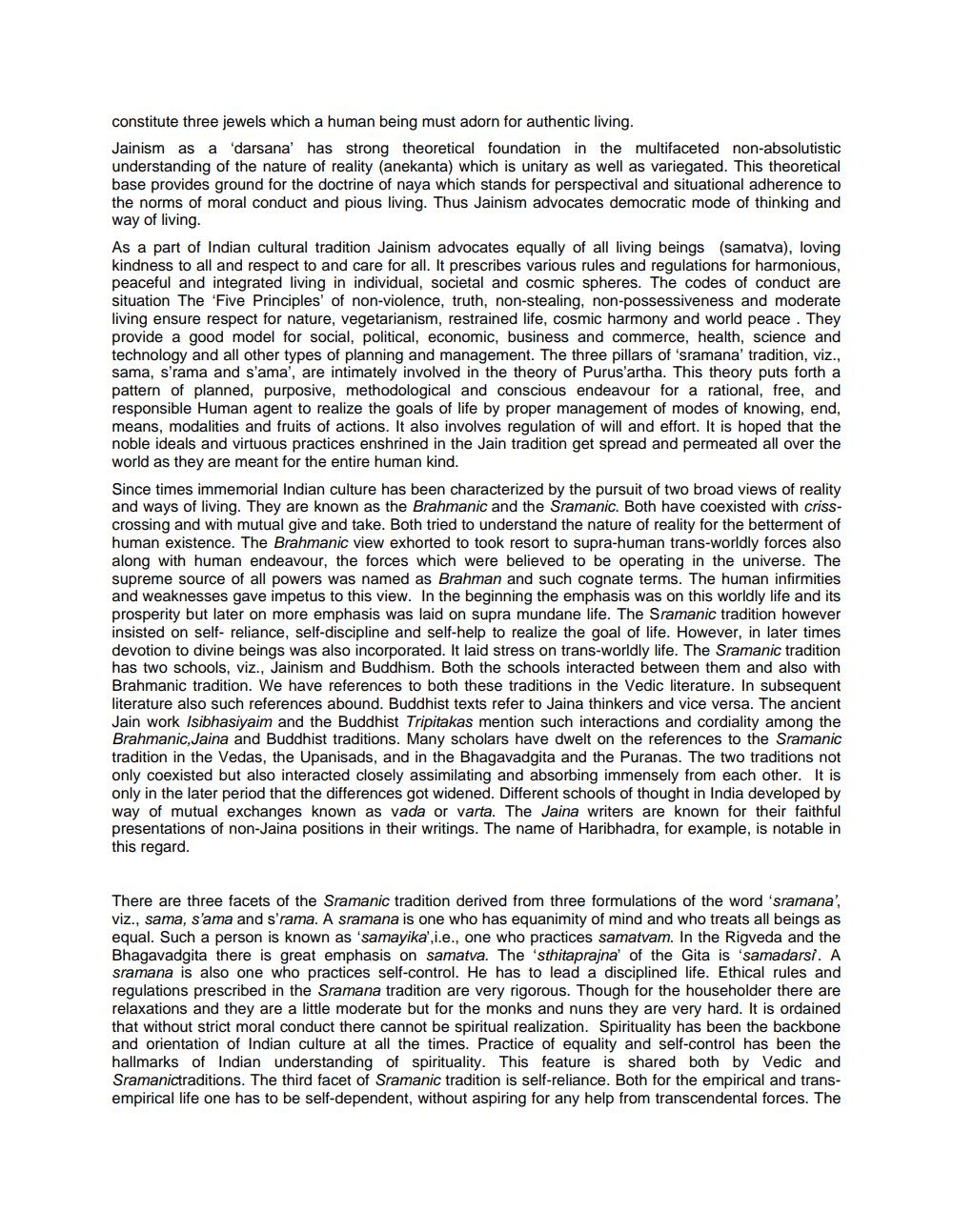Book Title: Jaina View Towards Philosophical Inquiry and Harmonious Ways of Living Author(s): S R Bhatt Publisher: ZZZ Unknown View full book textPage 4
________________ constitute three jewels which a human being must adorn for authentic living. Jainism as a 'darsana' has strong theoretical foundation in the multifaceted non-absolutistic understanding of the nature of reality (anekanta) which is unitary as well as variegated. This theoretical base provides ground for the doctrine of naya which stands for perspectival and situational adherence to the norms of moral conduct and pious living. Thus Jainism advocates democratic mode of thinking and way of living. As a part of Indian cultural tradition Jainism advocates equally of all living beings (samatva), loving kindness to all and respect to and care for all. It prescribes various rules and regulations for harmonious, peaceful and integrated living in individual, societal and cosmic spheres. The codes of conduct are situation The 'Five Principles of non-violence, truth, non-stealing, non-possessiveness and moderate living ensure respect for nature, vegetarianism, restrained life, cosmic harmony and world peace. They provide a good model for social, political, economic, business and commerce, health, science and technology and all other types of planning and management. The three pillars of 'sramana' tradition, viz., sama, s'rama and s'ama', are intimately involved in the theory of Purus'artha. This theory puts forth a pattern of planned, purposive, methodological and conscious endeavour for a rational, free, and responsible Human agent to realize the goals of life by proper management of modes of knowing, end, means, modalities and fruits of actions. It also involves regulation of will and effort. It is hoped that the noble ideals and virtuous practices enshrined in the Jain tradition get spread and permeated all over the world as they are meant for the entire human kind. Since times immemorial Indian culture has been characterized by the pursuit of two broad views of reality and ways of living. They are known as the Brahmanic and the Sramanic. Both have coexisted with crisscrossing and with mutual give and take. Both tried to understand the nature of reality for the betterment of human existence. The Brahmanic view exhorted to took resort to supra-human trans-worldly forces also along with human endeavour, the forces which were believed to be operating in the universe. The supreme source of all powers was named as Brahman and such cognate terms. The human infirmities and weaknesses gave impetus to this view. In the beginning the emphasis was on this worldly life and its prosperity but later on more emphasis was laid on supra mundane life. The Sramanic tradition however insisted on self-reliance, self-discipline and self-help to realize the goal of life. However, in later times devotion to divine beings was also incorporated. It laid stress on trans-worldly life. The Sramanic tradition has two schools, viz., Jainism and Buddhism. Both the schools interacted between them and also with Brahmanic tradition. We have references to both these traditions in the Vedic literature. In subsequent literature also such references abound. Buddhist texts refer to Jaina thinkers and vice versa. The ancient Jain work Isibhasiyaim and the Buddhist Tripitakas mention such interactions and cordiality among the Brahmanic, Jaina and Buddhist traditions. Many scholars have dwelt on the references to the Sramanic tradition in the Vedas, the Upanisads, and in the Bhagavadgita and the Puranas. The two traditions not only coexisted but also interacted closely assimilating and absorbing immensely from each other. It is only in the later period that the differences got widened. Different schools of thought in India developed by way of mutual exchanges known as vada or varta. The Jaina writers are known for their faithful presentations of non-Jaina positions in their writings. The name of Haribhadra, for example, is notable in this regard. There are three facets of the Sramanic tradition derived from three formulations of the word 'sramana', viz., sama, s'ama and s'rama. A sramana is one who has equanimity of mind and who treats all beings as equal. Such a person is known as 'samayika', i.e., one who practices samatvam. In the Rigveda and the Bhagavadgita there is great emphasis on samatva. The 'sthitaprajna' of the Gita is 'samadarsi. A sramana is also one who practices self-control. He has to lead a disciplined life. Ethical rules and regulations prescribed in the Sramana tradition are very rigorous. Though for the householder there are relaxations and they are a little moderate but for the monks and nuns they are very hard. It is ordained that without strict moral conduct there cannot be spiritual realization. Spirituality has been the backbone and orientation of Indian culture at all the times. Practice of equality and self-control has been the hallmarks of Indian understanding of spirituality. This feature is shared both by Vedic and Sramanictraditions. The third facet of Sramanic tradition is self-reliance. Both for the empirical and transempirical life one has to be self-dependent, without aspiring for any help from transcendental forces. ThePage Navigation
1 2 3 4 5 6 7 8 9 10 11
